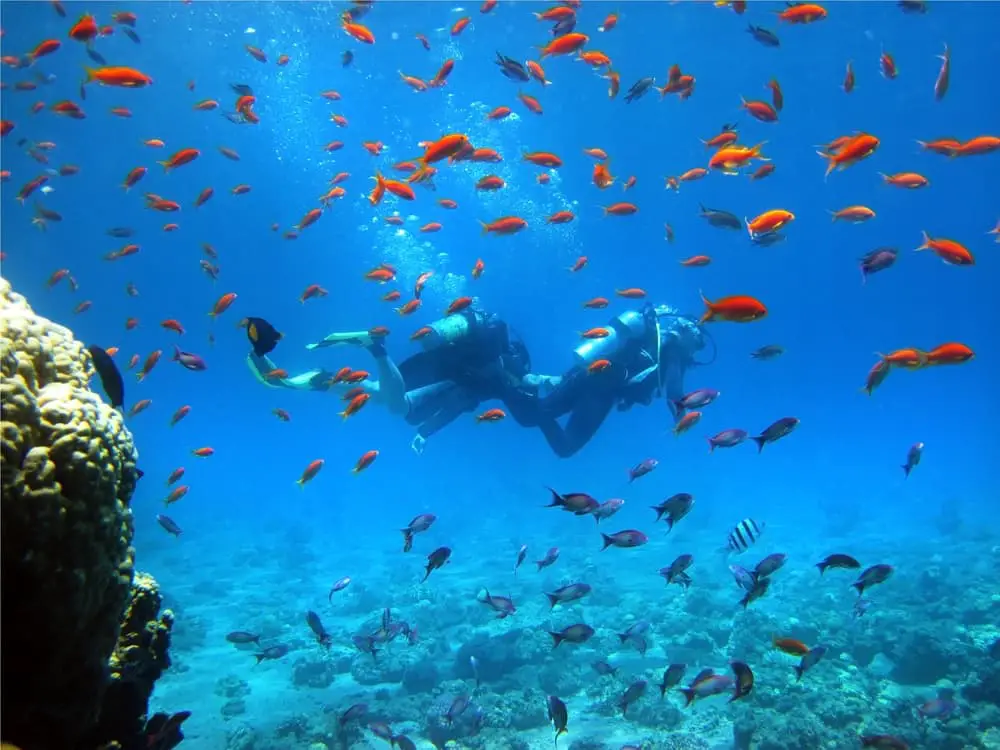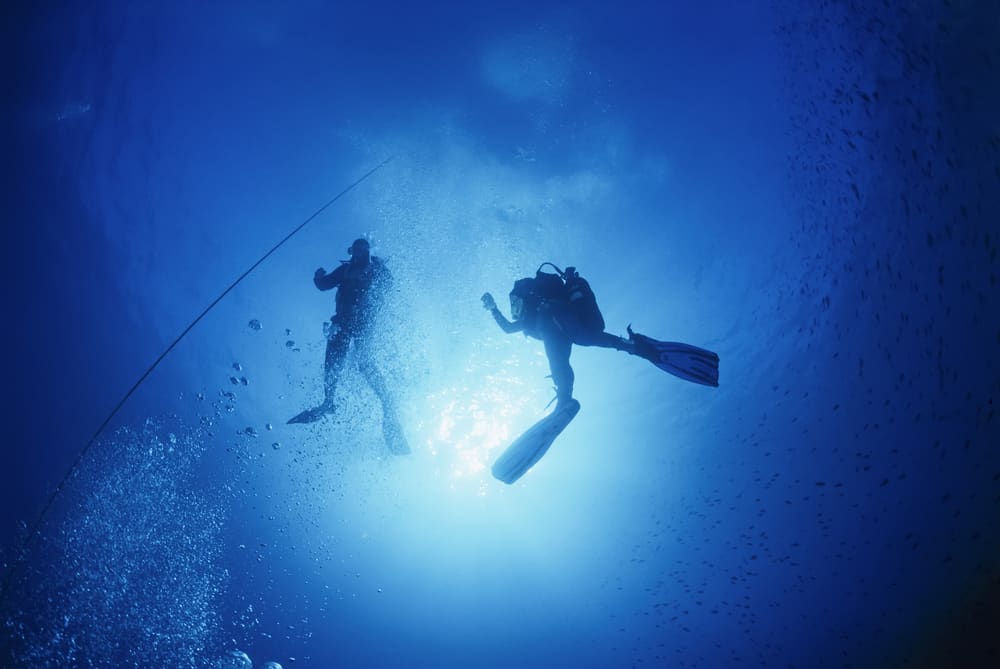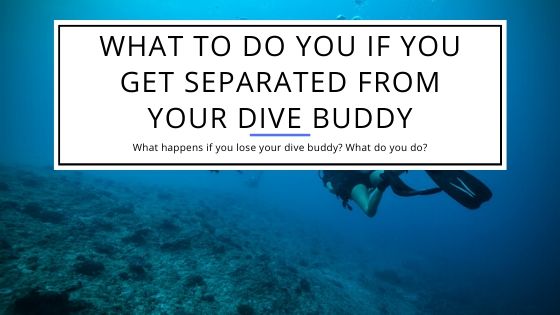What to Do You If You Get Separated From Your Dive Buddy
One of the most important things you learn when you are being certified to become a diver is that you should always stay with your dive buddy. Losing your dive buddy can be quite an ordeal, causing anxiety and disorientation mid-dive. In most cases, losing your dive buddy will end your dive abruptly, which no diver wants.
There are many reasons why having a dive buddy is important and why losing them can be such a challenge. Below we will discuss why having a buddy is important, how to prevent losing them, and what to do if you do get separated:
Why Do You Need A Buddy When Diving?
The buddy system is in place as a security measure for divers. Buddy diving can help divers avoid dangerous situations and even get out of certain conundrums. Divers will dive in groups of two or three at a time while using this system. The main reason for this is that the group of divers can look out for each other under the water and can be helpful in the case of emergencies. You may be an extremely experienced diver, but a diving buddy can save you life in a critical situation.
Before a dive, your buddy can help you get into your equipment and gear. Together, you can discuss the best techniques and locations to enter the water. Your buddy will also be with you to determine the route and depth of your dive; this will also help you stay together during your dive. Your dive buddy can help you in case you encounter a problem with your regulator, encounter an unknown marine creature, get stuck or even just help you stay calm if you feel yourself panicking underwater. Plus, it is always great to have someone there to experience the great sites and discoveries you make underwater with you.
How Was The Buddy System Invented?
Since the popularization of scuba diving for recreational purposes in the 1940s and 50s, regulations and safety precautions had started to be put into place. The YMCA first started the training programs for the new sport and kept the “never swim alone” rule that they had for swimming and lifeguard programs for scuba diving as well. This is because the underwater breathing apparatus’s invention had brought with it many fatal and near-death incidences when it first came around. As the buddy system proved itself over the years to be a useful addition to the sport, it solidified itself as one of the main rules of scuba diving.
Can You Dive Without A Buddy?
Yes, solo dives are possible. Solo dives either take place partly or completely without a dive buddy. These dives can start off with a buddy, and then divers can separate for their solo dive. Solo dives can also refer to dives where other divers are not trained or equipped to be helpful in the case of an emergency; during training, a trainer is said to be on a solo dive. Solo dives are rarely done for recreational purposes as they are dangerous; you will see that most dive centers highly discourage solo dives. Most solo dives are done by technical divers because it helps them stay focused on the task and sometimes is unavoidable.
What Leads to Buddy Separation?
There are many factors that can lead to you becoming separated from your dive buddy. You should be aware of these situations so you can plan accordingly and avoid any mishaps. Below are some of the most common reasons for getting separated:
Poor Visibility
This is possibly the most common reason why buddies get separated underwater. When divers are swimming in low visibility water, and they do not keep open communication, they can lose sight of each other and get separated. Use dive lights or make noise by banging on your tank to avoid this situation.
Equipment Malfunctions
If your dive buddy is not attentive, and you are being delayed on your route because of a malfunction or any other problem with your equipment, it is possible to get left behind. To avoid this, keep in constant contact with your dive buddy, and pick one that is reliable and attentive to avoid such a situation.
Strong Currents and Other Dangerous Scenarios
Strong currents can push divers apart and be very dangerous. Unexpected scenarios can also separate you, like dangerous marine creatures coming in between. Be aware of what creatures you can encounter or the currents of the water you are diving; communicate with your buddy beforehand so you know what to do in case you encounter one of these situations.
Miscommunication
Clear communication between buddies is imperative. Miscommunication of dive routes, paths or any changes underwater can lead to buddy separation. Make sure you and your buddy have a clean line of communication and understand each other.

What Do You Do When You Get Separated From Your Dive Buddy?
Unfortunately, even if divers follow all the rules to stay with their buddy, they can sometimes get separated. The first thing to remember if that happens is to stay calm. Next, follow these steps:
The 360-Degree Turn
If you notice that you have been separated from your dive buddy, slowly conduct a 360-degree turn to make sure they are nowhere around you. This includes looking above and beneath you. Keep a lookout for your buddy’s bubbles; if you spot them, you have found your buddy.
Use Your Dive Light
In a low visibility situation, try to locate your buddy with the use of a dive light. If you have pre-decided on any light signals, use them at this time to see if you get a response from your buddy.
Create Sounds
Use an underwater whistle or a tank banger to create noise underwater to get your buddy’s attention. Stop to listen if your buddy is signaling you back; if you make noise at a stretch, it may get distorted and your buddy won’t be able to locate the origin.
Only One Minute
As a rule, do not spend more than a minute searching for your buddy. This can become a dangerous situation for you. This is when you should start your ascent.
Ascend And Safety Stop
Ascend to the surface slowly, and perform a safety stop when you reach 15 feet. Once you reach that depth, release your surface marker to let your buddy know where you are in case they are already at the surface.
Surface
Ascend all the way to the surface. If your buddy is not already at the surface, look for bubbles around where you are. Call out to your buddy, but do not go back into the water. Descending again can put your life in danger, and chances are your buddy is following the same procedure.
Return to the Dive Boat
Wait at the surface of the water for the predefined amount of time, and then make your way back to the dive boat. If your buddy is not on the boat, it is a good idea to now report them as missing.
How Can You Make Sure To Stay With Your Dive Buddy?
There are standard rules and equipment that exist to ensure that you do not get separated from your dive buddy. First things first, you need to communicate with your dive buddy before the dive to make sure that both of you follow the same conventional rules and regulations for underwater communication. Second, decide and clearly communicate the dive route and depth beforehand so there is no confusion once you are under the water.
Once you dive, keep open communication with your dive buddy through hand signals. Make use of underwater slates in case there is a change of plan in the dive or anything else you want to communicate to your buddy. The best way to ensure that you will not be separated from your dive buddy is through the use of a buddy line. It is a piece of equipment that tethers dive buddies together, especially to avoid separation in low visibility dives. You can also use dive lights to communicate with your buddy in low visibility or even by tapping on tanks to make noise.

Final Thoughts
Diving with a buddy can potentially save your life in a dangerous situation, so it can be a terrifying and extremely stressful situation if you get separated. Follow all the protocol to ensure you stay with your buddy, and do not panic if you get separated; just stop, think and act in a calm manner. Happy diving!

